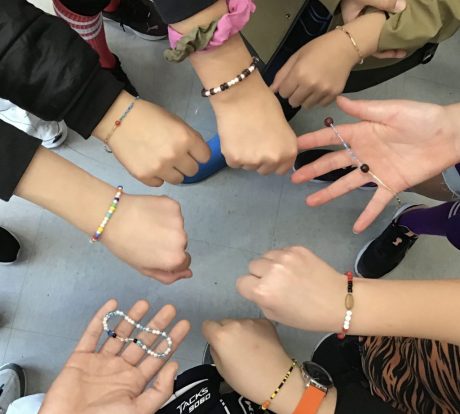Students have been exploring how to write numbers in binary code. Binary is a base-2 number system that is the foundation for machine commands. Each bit in this 6-bit series below can be turned either “on” or “off” in order to represent a value. When a bit is “on” it is represented with a 1, and when it is “off” it is represented with a 0. For example, in order to write the number 10 in binary, we would write 001010. The two 1s appear in the places of 8 and 2, so 8+2=10.

What is the largest number you can make with 6-bits? How would you represent the number 24?
Division 3–Have you noticed the strange addition sentence sticker on my laptop? Have a look the next time you’re here and see if you can solve it! (Hint: it has something to do with binary!)

This week students learned that letters can also be coded in binary using the ASCII alphabet. Each uppercase and lowercase letter can be represented by a decimal number that is translated into an 8-bit binary code. Students mapped out their the letters of their names on grid paper, chose their colours, and beaded their names into a bracelet. They used a different coloured bead as a delimiter to separate each 8-bit letter.
Here is a message for you, Division 3. Let’s see if you can decode it!
1001000 1000001 1010000 1010000 1011001 01000011 01001111 01000100 01001001 01001110 01000111
It starts with HAPPY …
Here is the decoding.
1001000 = sums up to 72 which is the ASCII value for upper case letter H
1000001 = sums up to 65 which is the ASCII value for upper case letter A
1010000 = sums up to 80 which is the ASCII value for upper case letter P
1010000 = sums up to 80 which is the ASCII value for upper case letter P
1011001 = sums up to 89 which is the ASCII value for upper case letter Y
… rest of it is for the students to decode and have fun!
I am sorry I couldn’t help but decode the message 🙂 It is the language of computers.
This is amazing and thank you Ms. Coutts for teaching this cool stuff to the children. Thank you!!
Fun fact – I have a friend whose masters thesis was written in binary!! Yes that is true.
Thanks,
Khurram
Thank you for sharing! All the students have a little ASCII key (just binary to alphabet) in their ADST duotangs.
If anyone is missing their key because you were away that day, please let me know!
This is a useful skill for kids, thx you for making this subject available for them.